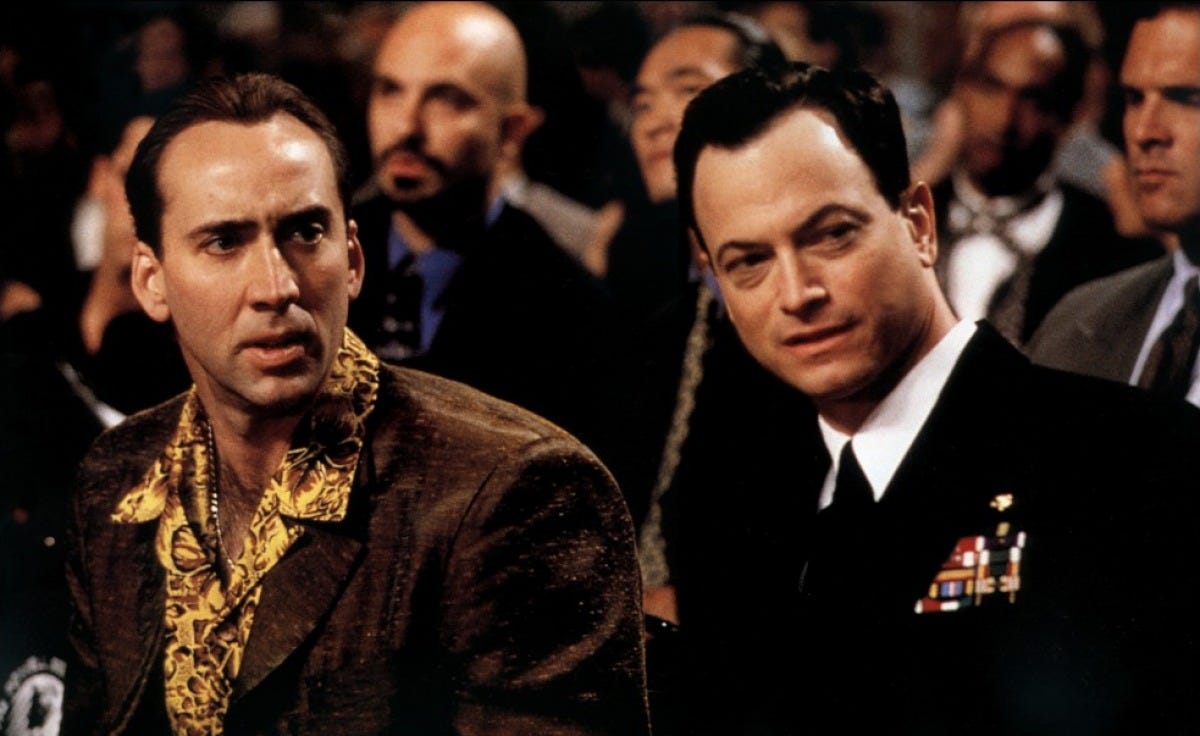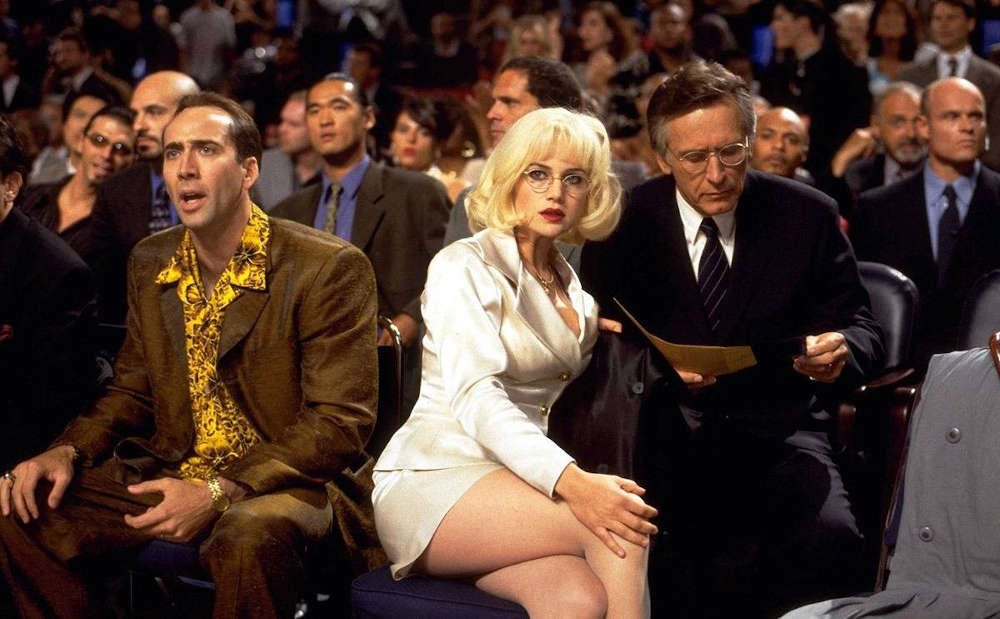1998 in Review: "Snake Eyes"
"I AAAM THE KING!"
Was Snake Eyes too early or too late? One thing we know: It was not on time. The 1998 conspiracy thriller was absolutely pilloried by critics. Roger Ebert said it was “the worst kind of bad film: the kind that gets you all worked up and then lets you down, instead of being lousy from the first shot.” Entertainment Weekly’s Owen Gleiberman gave it a D, concluding his vicious pan by crowning its director Brian De Palma the “masturbator of suspense.”
In recent years, Snake Eyes has been somewhat reclaimed by a generation of cinephiles more entranced by pure cinema than by story and character. No filmmaker is in love with the tools of filmmaking like De Palma, who was worshiped by the other mavericks of New Hollywood—Lucas, Spielberg, and Scorsese—for his knowledge and acumen. In his suspense films, many of which are heavily influenced by Alfred Hitchcock, De Palma luxuriates in POV shots, unreliable narrators, split screens, split diopters, and dutch angles. Best of all, these techniques are not, as Gleiberman accused, masturbatory. They all serve his voyeuristic obsession. In one way or another, all of his films are about watching.
From its very first shot, Snake Eyes is about the way we watch it. It opens with a famous long take in which Atlantic City cop Rick Santoro (Nicolas Cage) surveys the scene at the Millennium Casino on the night of a major boxing match. He chats with his bookie, shakes down a petty crook for some cash, returns to his bookie, flirts with a few girls, chats on his cell phone with his wife, puts her on hold for his girlfriend, and finally meets up with his best friend, Kevin Dunne, a Navy commander who has a seat saved for Santoro right in front of the Secretary of Defense. The 20-minute Steadicam shot (which has at least one or two hidden cuts) concludes with the Secretary being shot in the throat by an unseen assassin.
With a hurricane raging outside the casino doors, Santoro works quickly to solve the murder and protect a beautiful, young girl (Carla Gugino) who is wrapped up in it, and as he does, De Palma returns us to this opening sequence many times, showing it from new angles and POVs. There are cameras all over the building. The casino manager tells Santoro at one point there are “quadruple redundancies” on the floor. A well-lit, highly-surveilled area filled with horny, violent people? This is De Palma’s wet dream, and he makes the most of it, using all his tools to revisit that opening shot, answering nagging questions and raising new ones with every turn. The rewards and the limits of looking seep into every frame.
It might have felt like a retread to De Palma’s fans. The director explored many of the same themes in 1982’s Blow Out. Either way, it’s not the film that critics wanted from De Palma, who had just revived his reputation with the first Mission: Impossible the year before. Looking back, the shape of his career becomes clear. De Palma would make a big commercial movie every ten years or so; the decade prior, he had done The Untouchables just when his career was at a nadir. It’s a savvy strategy that kept De Palma in the studios’ good graces and attracted major movie stars to his projects, while giving him leeway to continue pursuing his perverse obsessions. Gleiberman’s review of Snake Eyes is instructive. He chides De Palma for falling in love with his own technique, writing that he was “so tone-deaf to practical priorities that he’d happily stage birth videos of his own children to look like Hitchcock climaxes, if he could only lay dolly tracks in the delivery room.” As if that’s a bad thing.
Previously in this space, I’ve praised filmmakers who revisit the same themes and stories throughout their career. All filmmakers have obsessions; it’s fun when they lean into it and test the strength of their invented myth in new settings and eras. Much like Blow Out, Snake Eyes invokes the original act of real-world violence that turned his entire generation into obsessives. When the Secretary of Defense is shot, his hands go to his throat in just the way Kennedy’s did after he was shot in Dallas. The character played by Gugino shows up to this scene wearing a blonde wig, looking much like Marilyn, but after she is splattered with the politician’s blood, her wig flies off, revealing short brown hair—more like Jackie. The murder reveals itself to be (SPOILER ALERT) the work of the military-industrial complex, which takes down the Defense Secretary in order to ensure approval of a new missile he was planning to bury. Snake Eyes comes a few years after the double shot of JFK and In the Line of Fire, which respectively provoked and soothed the obsessions of a generation haunted by the loss of their hero. Maybe that’s why the message got lost. The generation had already moved on. Or maybe it’s the fact that De Palma provides no resolution to this existential wound, just well-expressed themes wrapped around an otherwise slight conspiracy plot.
No, Snake Eyes doesn’t always hold up as a work of pure entertainment. The plot itself feels a little half-baked, although the central idea of a military-industrial complex using a radical Islamist as a false flag would surely have resonated more a few years later. In one of his more confused performances, Cage feels stuck between his more traditional leading man work and the gonzo expressionism that would soon become his trademark. And the finale feels oddly, although perhaps purposely, anticlimactic, which might be explained by the fact that a big VFX-driven moment in which a tidal wave rushes through the casino was cut from the finished film. For those looking for GREAT ART, or worse yet, another Mission: Impossible, Snake Eyes would surely disappoint.
No matter: Being both too early and too late is just another way of being timeless. Even if it doesn’t make De Palma’s rather long list of outright masterpieces (Sisters, Carrie, Body Double, Blow Out, Casualties of War, Carlito’s Way, Mission: Impossible, and maybe Scarface), Snake Eyes deserves a better legacy for how it snakes the border between art and trash. It’s a slick thriller that’s shallow and deep at once, and it makes you realize there’s not that much distance between them in the first place.




"Being both too early and too late is just another way of being timeless." Great line. Loved the piece.